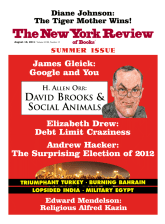In response to:
The Charms of Eleanor from the June 9, 2011 issue
To the Editors:
I was very pleased to read the review of the books on Eleanor Roosevelt by Russell Baker [NYR, June 9], which captures the important place that this “First” of First Ladies had in America’s heart as well as in American politics and social reform in the twentieth century. But it was disappointing that Baker claims that these books offer “a fresh view of Eleanor’s unorthodox world and the women and men she loved.” Blanche Wiesen Cook’s magisterial two-volume (a third to come shortly, we hope) biography of Eleanor offered the first and most complete view of that world, as even Hazel Rowley states in her acknowledgments: “I feel particular gratitude to Blanche Wiesen Cook, who…dared to show ER as a passionate woman, and to suggest that she might actually have had a physical relationship with LH [Lorena Hickok]—and, indeed, with Earl Miller. Cook took quite a bit of flak for turning the icon into a woman of flesh and blood. I come along gratefully in her shadow.”
Gerald Markowitz
Distinguished Professor of History
John Jay College and Graduate Center, CUNY
New York City
To the Editors:
In Russell Baker’s review of two new books about Eleanor and Franklin Roosevelt (Hazel Rowley’s Franklin and Eleanor: An Extraordinary Marriage and Maurine H. Beasley’s Eleanor Roosevelt: Transformative First Lady), he finds the books “sound and entertaining” additions to the voluminous writings about the Roosevelts, while also seeming to lament the continued “public curiosity” about their personal lives. While noting that “in all regions, commentators friendly to corporate power walloped her for harboring sympathetic views on labor unions,” he stays resolutely focused on ER’s personal relationships. There is little more about labor in the two fine volumes he reviews.
Published the same month, however, was a third book, She Was One of Us: Eleanor Roosevelt and the American Worker (Cornell), in which I detail for the first time Eleanor Roosevelt’s enduring commitment to workers and their unions and how she translated that commitment into action. Her understanding of wages and working conditions began in a settlement house on the Lower East Side of Manhattan where she volunteered as a young debutante. From Rose Schneiderman and the Women’s Trade Union League she learned about progressive unions that extended worker concerns to issues of health care, housing, financial assistance, and cultural life. She took Franklin to the tenements with her and brought Rose Schneiderman into their home.
During the New Deal, Eleanor Roosevelt not only encouraged and supported labor legislation, but in 1936 she celebrated the first anniversary of her My Day column by very publicly joining the American Newspaper Guild, CIO, and was a proud union member for over twenty-five years. While First Lady she reached out to miners, steel and electrical workers, railroad porters, migrant farm workers, and teachers. By 1940, she saw labor unions as exemplifying a “fundamental element of democracy.” She took this belief to the United Nations where she worked closely with colleagues in the labor movement to secure labor rights in the Universal Declaration of Human Rights.
Brigid O’Farrell
Project Director and Lecturer
Mills College
Oakland, California
This Issue
August 18, 2011
What Were They Thinking?
Fooled by Science
How Google Dominates Us



